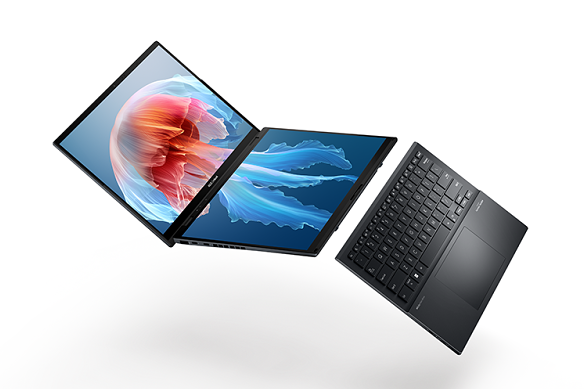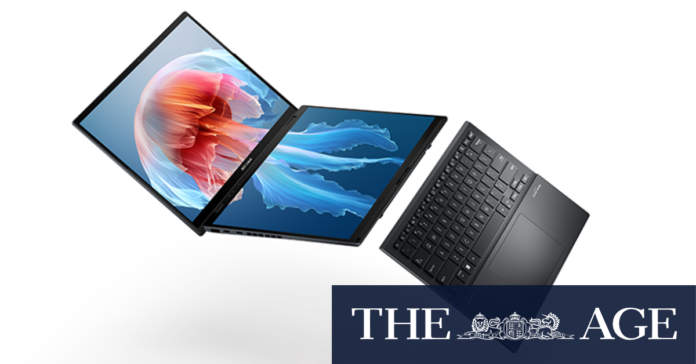[ad_1]
Laptops with two screens have been a thing for around a decade but have never truly taken off. From small, less-than-useful screens to cramped keyboards to fiddly software, there’s always some major compromise that overshadows any potential benefit. But with this year’s ASUS Zenbook Duo, the format might have finally found its sweet spot, with a device that works great as a standard laptop as well as a dual-screen monster.
When it’s all folded up, the $4000 Duo is indistinguishable from any other slightly chunky power-user laptop. And even when you open it, what you see is a nice 14-inch screen up top and a standard keyboard and touchpad combo on the bottom. But the keyboard’s attached with firm magnets, and when you lift it away, you’ll automatically activate the second screen underneath. From here, you can use it in a number of ways.

The new Zenbook Duo is the first two-screen laptop that feels properly useful.
ASUS includes some comprehensive, if confusing, software to configure the bottom screen with virtual gadgets from keyboards and trackpads to dials and switches, so you can use it in standard laptop mode with access to the same controls you might have in a studio. Or, you can pop out the kickstand and open the laptop up for two 14-inch screens stacked on top of each other. Add your own keyboard and mouse, or just use that keyboard and trackpad you removed earlier. You could also stand the laptop up like a book for two (surprisingly stable) narrow displays. Or lay it flat on the table for stylus work or show something to someone across from you.

The Duo doesn’t lie completely flat, but it’s close enough.
The utility of the physical keyboard, the quality of the two screens, and the stability of the kickstand are really what set the Duo apart from previous two-screen laptops. Even last year’s Yoga Book 9i from Lenovo insisted you use a virtual trackpad all the time, and came with a folding stand you had to carry around. The Duo’s keyboard and trackpad are full-sized, sturdy, feel great and have backlighting, which means you can use this thing as a totally standard laptop without it feeling creaky or compromised. The keyboard charges when docked and lasts a good few hours on its own while detached, but it also has a USB-C port if you need to power it all day.
Both screens feature vibrant Dolby Vision HDR OLED panels at a 3K resolution (that’s 2880 x 1800), with up to a 120Hz refresh rate, meaning they’re sharp, smooth and beautiful to look at. Windows isn’t great for moving things around between screens, but ASUS has done a decent job fixing that; you can drop any window into a series of buckets to send it to either screen in one of a few different shapes. The displays are also touchscreens, and the Duo comes with a stylus, though there’s nowhere on the laptop to stow it.
I was relatively pleased with the battery life, though with two screens, it’s obviously lower than other laptops, at around eight hours of heavy use. Performance was also very impressive from the 32GB of RAM and Intel’s latest Ultra 9 Processor, which (of course, because it’s 2024) claims to have discrete cores for processing AI tasks. If the Duo has a weakness it’s that it’s somewhat lacking in ports. There’s an HDMI 2.1, a pair of USB-C Thunderbolt 4, a USB-A 3.2 Gen 1, and a good old 3.5mm audio jack.
Another element that should be noted is the price. At $4000, the new Duo is clearly priced as a premium laptop. But given the specs and the extra screen, it actually ends up being very competitive with premium standard laptops, which hasn’t generally been the case with multiple-screen units. A comparable Microsoft Laptop Studio, for example, is $4879, though it comes with a discrete graphics chip, while the cheapest possible MacBook Pro with at least that much RAM as the Duo is $4100.
[ad_2]
Source link


